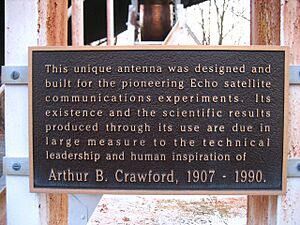Holmdel Horn Antenna facts for kids

The Holmdel Horn Antenna in use in 1962
|
|
| Named after | Holmdel Township |
|---|---|
| Location(s) | Holmdel Township, Monmouth County, New Jersey |
| Coordinates | 40°23′27″N 74°11′05″W / 40.39072°N 74.18483°W |
| First light | 1959 |
| Telescope style | cosmic microwave background experiment horn antenna radio telescope |
| Diameter | 20 ft (6.1 m) |
|
Holmdel Horn Antenna
|
|
| Built | 1959 |
| Architect | A.B. Crawford |
| NRHP reference No. | 89002457 |
| Significant dates | |
| Added to NRHP | December 20, 1989 |
| Designated NHL | December 20, 1989 |
The Holmdel Horn Antenna is a large horn antenna located in Holmdel Township, New Jersey, United States. It was built in 1959 at Bell Telephone Laboratories. This antenna was first used for communicating with satellites. Later, it became a radio telescope to study radio waves from space.
In 1965, two scientists, Arno Penzias and Robert Wilson, used this antenna. They made an amazing discovery: the cosmic microwave background radiation (CMBR). This radiation is a faint glow of energy coming from every direction in the universe. It was a huge clue that helped prove the "Big Bang" theory. This theory explains how the universe began. Their discovery changed how scientists study the universe. Penzias and Wilson won the Nobel Prize for Physics in 1978 for their work. The antenna was named a National Historic Landmark in 1989 because of its importance.
Contents
What is the Holmdel Horn Antenna?
The horn antenna at Bell Telephone Laboratories was built to help with Project Echo. This was a NASA project that used large, shiny balloons in space. These balloons acted like mirrors, bouncing radio signals from one place on Earth to another.
The antenna is about 50 feet (15 meters) long. Its opening, where it collects radio waves, is 20 by 20 feet (6.1 by 6.1 meters). It is made from aluminum. A large wheel, 30 feet (9.1 meters) wide, supports the antenna's weight. This wheel allows the antenna to tilt up and down.
The antenna also has a strong base frame made of steel. This base rotates on wheels around a central point. The track for these wheels is very flat and precise. This design allows the antenna to point to any part of the sky. It can turn left or right (azimuth) and tilt up or down (elevation).
Inside a special room near the antenna's narrow end, there is equipment. This equipment includes a radiometer. A radiometer measures the strength of radio waves. Placing this equipment close to the antenna helps reduce unwanted noise.
The antenna was designed to handle strong winds up to 100 miles per hour (160 km/h). The whole structure weighs 18 short tons (16 metric tons). When not in use, it can turn freely. This lets it face away from the wind, like a weathervane, to protect itself.
Next to the antenna, there is a small shed. This shed is 10 by 20 feet (3.0 by 6.1 meters) and holds the controls and other equipment for the antenna. This shed is also part of the National Historic Landmark. The antenna has not been used for many years.
How the Antenna Helped Science
This type of antenna is called a Hogg or horn-reflector antenna. It was invented in 1941 by Alfred C. Beck and Harald T. Friis. David C. Hogg built this specific antenna. It looks like a giant metal horn with a curved mirror inside. This mirror helps focus the radio waves.
The Hogg horn antenna is very good for radio astronomy for several reasons:
- It can pick up a wide range of radio frequencies.
- It is very efficient at collecting signals.
- Its design blocks out most radio waves coming from the ground or sides. This means it mostly picks up signals from space.
Because it blocks out ground noise so well, it was perfect for measuring very weak radio signals from the universe. This made it an ideal tool for discovering the faint cosmic microwave background radiation. The antenna has a gain of about 43.3 dBi. This means it is very good at picking up weak signals. It also has a narrow beamwidth of about 1.5 degrees at 2.39 GHz. This means it can focus on a small area of the sky.
Saving the Antenna: A Community Effort
In 2021, the land where the antenna sits was sold to a company that wanted to build homes. This made many people worried that the antenna and its important site might be destroyed.
A group of people started a "Save Holmdel's Horn Antenna" effort. They created a petition to turn the area into a park. More than 8,000 people signed the petition, showing strong public support.
Because of this community support, the Holmdel Township Committee decided to buy the land. In October 2023, they agreed to pay $5.5 million for 35 acres (14 hectares) of land, which includes the antenna. The town plans to turn this land into a public park. This means the Holmdel Horn Antenna will be preserved for future generations to see and learn about.
See also
- Andover Earth Station, another large Hogg horn antenna location








